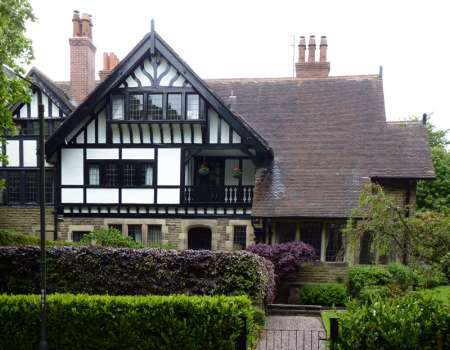“Farringford” and” Somersby,”* 1-3 College Road, Buxton
*Farringford on the Isle of Wight was home to Alfred, Lord Tennyson (1809-1892), Somersby Rectory in Lincolnshire was where he was born.
Pair of semi-detached houses. 1896. By Barry Parker and Raymond Unwin. Rock-faced millstone grit with ashlar dressings and timber-framing. Plain tile roof with 4 tall red brick stacks.
EXTERIOR: 2 storeys and attic. Chamfered plinth. Street front has stone ground floor with timber-framing above. Irregular 5-window front. No 1 has central recessed doorway with flat headed Tudor style door with moulded cornice, to right a stone bench and various mullion windows. To left at corner a stone canted bay window. Above jettied first floor has 5-light casement to left and to right a balcony with wooden balusters and set-back door and overlight. Above jettied 8-light oriel window with curved framing in gable. Left return has irregular fenestration and projecting 2 storey gabled wing. No 3 has recessed doorway with flat headed Tudor style door with moulded cornice, flanked by stone mullion windows. Above a 4-light wooden casement window to left with balcony above and small set-back gabled dormer with 3-light casement. To right a jettied gable with a 4-light mullion to left and a balcony to right with wooden baluster and door, above a jettied 5-light wooden oriel window and curved framing in gable. Right return has 3 irregularly spaced windows. To left a 2 storey gabled wing with 4-light mullion windows to each floor. To right a square window and a 4-light mullion window beyond, similar arrangement above with further 4-light window in central gable.
INTERIOR: much of the interior of No 1 (Seven Ways) survives intact. The dining room with corner fireplace has original copper canopy (but grate removed), and distinctive pillar, shaped to capital and chamfered and stopped to base, with fitted seats and book case: the polygonal corner further emphasised by a shallow arched "entrance". Stairs of pierced splat balusters. The right-hand room retains an inglenook with painted brick arch, beams and "fire window". Original doors with panels of diagonal boarding and original ironmongery survive. A dumb waiter (to left of entrance) has been removed. Somersby is reputed to retain its original hall fireplace and the stone staircase, some doors and cupboards and the sitting room inglenook arch.
